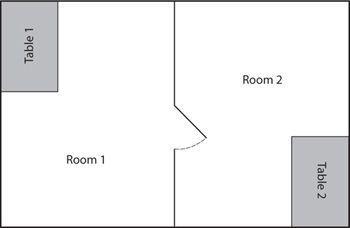yet speakers of Guugu Yimithirr and Tzeltal overwhelmingly chose the geographic solution even under such “adverse” conditions.

Does all this mean that we and speakers of Guugu Yimithirr sometimes remember “the same reality” differently? The answer must be yes, at least to the extent that two realities that for us can look identical will appear different to them. We, who generally ignore rotations, will perceive two arrangements that differ only by rotation as the same reality, but they, who cannot ignore rotations, will perceive them as two different realities. One way of visualizing this is to imagine the following situation. Suppose you are traveling with a Guugu Yimithirr friend and are staying in a large chain-style hotel, with corridor upon corridor of identical-looking doors. Your room is number 1264, and your friend is staying in the room just opposite yours, 1263. When you go to your friend’s room, you see an exact copy of yours: the same little corridor with a bathroom on the left as you enter, the same mirrored wardrobe on the right, then the main room with the same bed on the left, the same indistinct-brown curtains drawn behind it, the same elongated desk next to the wall on the right, the same television set on the left corner of the desk and the same telephone and minibar on the right. In short, you have seen the same room twice. But when your Guugu Yimithirr friend comes into your room, he will see a room that is quite different from his, one where everything is reversed. Since the rooms face each other (rather like rooms 1 and 2 in the picture shown here), and since they have been arranged to look the same from the egocentric perspective, they are actually north-side-south. In his room the bed was in the north, in yours it is in the south; the telephone that in his room was in the west is now in the east. So while you will see and remember the same room twice, the Guugu Yimithirr speaker will see and remember two different rooms.
One of the most tempting and most common of all logical fallacies is to jump from correlation to causation: to assume that just because two facts correlate, one of them was the cause of the other. To reduce this kind of logic ad absurdum, I could advance the brilliant new theory that language can affect your hair color. In particular, I claim that speaking Swedish makes your hair go blond and speaking Italian makes your hair go dark. My proof? People who speak Swedish tend to have blond hair. People who speak Italian tend to have dark hair. QED. Against this epitome of tight logical reasoning you may come up with a few petty objections along these lines: Yes, your facts about the correlation between language and hair color are perfectly correct. But couldn’t it be something other than language that caused the Swedes to have blond hair and the Italians dark? What about genes, for instance, or climate?
Now, as far as language and spatial thinking go, the only thing we have actually established is correlation between two facts: the first is that different languages rely on different coordinate systems; the second is that speakers of these languages perceive and remember space in different ways. Of course, my implication all along was that there is more than just correlation here and that the mother tongue is an important factor in
Nevertheless, the argument advanced here is that a language like Guugu Yimithirr
The causal link between language and spatial thinking thus seems far more plausible than the case of language and hair color. Still, plausibility by no means constitutes proof. And as it happens, some psychologists and linguists, such as Peggy Li, Lila Gleitman, and Steven Pinker, have challenged the claim that it is primarily language that influences spatial memory and orientation. In
What is more, says Pinker, the environment determines not just the choice between egocentric and geographic coordinates but even the particular type of geographic coordinates that will be used in a language. It is surely not a coincidence that the Tzeltal system relies on a prominent geographic landmark, whereas the Guugu Yimithirr system uses compass directions. The environment of Tzeltal speakers is dominated by a visible landmark, the uphill-downhill slope, and so it is only natural for them to depend on this axis rather than on the more elusive compass directions. But as the environment of the Guugu Yimithirr lacks such prominent landmarks, it is no wonder that their axes are based on compass directions. In short, Pinker claims that the environment has decreed for us what coordinates we think in, and it is spatial thinking that determines spatial language, not vice versa.
While Pinker’s facts are hardly quibbleable with, his environmental determinism is unconvincing for several reasons. It makes sense, of course, that each culture would home in on a coordinate system suitable for its environment. Still, it is crucial to realize that different cultures have a considerable degree of freedom. For example, there is nothing in the physical environment of the Guugu Yimithirr that precludes their using
What is more, there are odd pairs of languages around the world that are spoken in similar environments but have nevertheless chosen to rely on different coordinate systems. Tzeltal, as we have seen, uses geographic coordinates almost exclusively, but Yukatek, another Mayan language of a rural community from Mexico, predominantly employs egocentric coordinates. In the savannah of northern Namibia, the Hai||om bushmen speak about space like the Tzeltal and Guugu Yimithirr, whereas the language of the Kgalagadi tribe from neighboring Botswana, who live in a similar environment, relies heavily on egocentric coordinates. And when two

